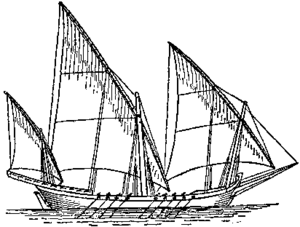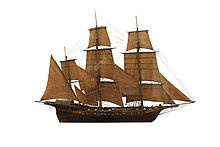Xebec
| Xebec | |
|---|---|
 A xebec with three lateens and oars | |
| Type | Sailing vessel |
| Place of origin | ProbablyAlgeria[1][2] |
| Service history | |
| In service | 16th to mid-19th century |
| Used by | MainlyMENAstates Sometimes used inEurope |
| Specifications | |
| Mass | 100–200 tons, in some cases up to 600 t |
| Crew | 90 to 400 |
Axebec(⫽ˈziːbɛk⫽or⫽zɪˈbɛk⫽), also spelledzebec,was aMediterraneansailing shipthat was used mostly for trading. Xebecs had a long overhangingbowspritand aft-set mizzenmast.The term can also refer to a small, fast vessel of the sixteenth to nineteenth centuries, used almost exclusively in theMediterranean Sea.
Description[edit]
Xebecs were ships similar togalleysprimarily used byBarbary pirates,which have bothlateensails and oars for propulsion. Early xebecs had twomastswhile later ships had three. Xebecs featured a distinctivehullwith pronounced overhangingbowandstern,[3]and rarelydisplacedmore than 200tons,making them slightly smaller and with slightly fewer guns thanfrigatesof the period.
Use by Barbary corsairs[edit]

These ships were easy to produce and were cheap, and thus nearly every corsair captain (Raïs) had at least one xebec in his fleet. They could be of varying sizes. Some ships had only three guns[4]while others had up to forty.[5]Most xebecs had around 20–30 cannons, and the overwhelming majority hadswivel gunsequipped.[6][7]
After the 18th century, galleys became increasingly outdated and xebecs became the preferred ships of Barbary pirates[8]thanks to their heavy and effective use of wind power, reduced need for slaves to row, ability to carry more cannons than a galley, and overall cheapness, speed,[9]and maneuverability.[10]
Xebecs were generally faster than contemporary ship types until the introduction ofsteamships.
Corsairs built their xebecs with a narrow floor to achieve a higher speed than their victims, but with a considerablebeamin order to enable them to carry an extensivesail-plan.Thelateenrig of the xebec allowed the ship to sail close hauled to the wind, often giving it an advantage in pursuit or escape. The use of oars or sweeps allowed the xebec to approach vessels who were becalmed. When used as corsairs, the xebecs carried a crew of between 90[4]and 400 men.
The use ofsquare rigamong pirates was initially rare, although after the 1750s a mix between lateen and square rigs became much more widespread.[10]
Use by European powers[edit]
Some victorious xebecs of the Spanish Navy, about 1770 (seeAntonio Barcelócampaigns... in the Spanish version of the page of Wikipedia):
- Andaluz,30 guns (4 × 8-pounders)
- Africa,18 guns (4-pounders)
- Atrevido,20 guns
- Aventurero,30 guns (3 × 8-pounders)
- Murciano,16 guns, 4 pedreros (lightswivel guns)
- San Antonio
Notable xebecs of the French Navy include four launched in 1750:
- Ruse,160 tons, 18 guns
- Serpent,160 tonsburthen,18 guns
- Requin,260 tons burthen, 24 guns
- Indiscret,260 tons burthen, 24 guns

In the eighteenth and early nineteenth centuries, a largepolacre-xebec carried asquare rigon theforemast,lateensailson the other masts, abowsprit,and twoheadsails.The square sail distinguished this form of a xebec from that of afeluccawhich is equipped solely withlateensails. The last of the xebecs in use by European navies were fully square-rigged and were termed xebec-frigates.
The British brig-sloopSpeedy's (14 guns, 54 men) defeat of the Spanish xebec-frigateEl Gamo(32 guns, 319 men) on 6 May 1801 is generally regarded as one of the most remarkablesingle-ship actionsin naval history. It was the foundation of the legendary reputation of theSpeedy's commander,Lord Cochrane,which has in turn provided the inspiration forsea fictionsuch asPatrick O'Brian'sMaster and Commander.[11]

Etymology[edit]
Xebec is also written asxebeck,xebe(c)que,zebec(k),zebecque,chebec,shebeck(⫽ʃɪˈbɛk⫽); from (Catalan:xabec,French:chabec,nowchebec,Spanish:xabeque,nowjabeque,Portuguese:enxabeque,nowxaveco,Italian:sciabecco,zambecco,stambecco,Maltese:xambekk,Greek:σεμπέκο,sebecoLigurian:sciabécco,Arabic:شباك,šabbākandTurkish:sunbeki). Words similar in form and meaning toxebecoccur in Catalan, French, Spanish, Portuguese, Italian, Arabic and Turkish. TheOnline Etymology Dictionaryregards theArabicshabbak(meaning "a smallwarship") as the source form; however, the Arabic root means 'a net', implying the word originally referred to a fishing boat.
See also[edit]
References[edit]
- ^"Chébec: Maquette de bateau historique signée Historic Marine".
- ^Olivier d 'Orbcastel, Chebec – Slaves of the Barbarians in Algiers
- ^King, Dean (2000).A Sea of Words(3 ed.). Henry Holt. p. 476.ISBN978-0-8050-6615-9.
- ^abNorie, John William (1842).The Naval Gazetteer, Biographer and Chronologist: Containing a History of the Late Wars from... 1793 to... 1801; and from... 1803 to 1815, and Continued, as to the Biographical Part to the Present Time.C. Wilson.
- ^Journal of the Royal United Service Institution, Whitehall Yard.W. Mitchell. 1916.
- ^York State Tradition.York State Tradition. 1968.
- ^Clarke, James Stanier.The Naval Chronicle [ed. by J.S. Clarke, S. and J. Jones].
- ^Devoulx, Albert (1872).Le registre des prises maritimes(in French). A. Jourdan.
- ^Fawcett, Nick (2019-07-11).Can I Have a Word?: A Fun Guide to Winning Word Games.Little, Brown Book Group.ISBN978-1-4721-4311-2.
- ^abLaszlo, Veres; László, Veres; Woodman, Richard (1999).The Story of Sail.Naval Institute Press.ISBN978-1-55750-896-6.
- ^David Cordingly (2007).Cochrane: The Real Master and Commander.New York: Bloomsbury. pp. 3–4.ISBN978-1-58234-534-5.
External links[edit]
- Arabian chebecHigh-resolution photos of a model of an eighteenth-century xebec
- book "Chebec Le Requin 1750" with English Translation, by Jean Boudroit, 1991
- [1]Definition of xebec source
